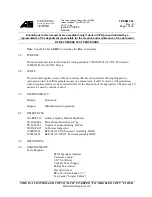
Page
8
ML442 | v5k
Expo Technologies UK
T: +44 (0) 20 8398 8011
Expo Technologies US
T: +1 (440) 247 5314
Expo Technologies China
T: +86 532 8906 9858
4. Installation of the System
This MiniPurge
is designed for use under normal industrial conditions of ambient temperature,
humidity and vibration. Please consult Expo before installing this equipment in conditions that
may cause stresses beyond normal industrial conditions.
The MiniPurge
system shall be installed in accordance with relevant standards, such as IEC /
EN 60079-14, NEC 500, NFPA 496 and any local codes of practice that are in force.
There are up to three components for the MiniPurge
system, dependent upon the system type:
System type
Control Unit (CU)
Relief Valve
(RLV)
Spark Arrestor
Unit
Leakage Compensation
YES
YES
Integral to RLV
Continuous Flow
YES
YES
YES (SAU25)
Table 1 System Components
4.1 Control Unit (CU)
The MiniPurge
system should be installed either directly on or close to the PE. See mounting
details. Generally the most convenient arrangement is to install the CU on the top of the PE.
Must be mounted vertically as shown in MiniPurge
Configuration XBR-7TD0-003. The CU can
be mounted on the side of the PE using the rear mounting fixings. The piped connections to the
PE should be made using metallic tube through suitable bulkhead connections. The CU can be
remote mounted using the wall mounting bars (/WM option), and should be installed as close as
possible to the PE. It should be installed so that the system indicators and certification labels
may be readily observed.
4.2 Relief Valve (RLV) and Spark Arrestor Unit (SAU)
To achieve efficient purging the points where air enters and exits the PE should normally be at
opposite ends of the PE. These items must be mounted vertically. The RLV or SAU are
recommended to be situated at the bottom, or on the side of the enclosure at the bottom, when
the CU is top mounted on the enclosure, thus achieving top to bottom purging. The purge air
may be piped within the PE to ensure purging of potential dead air spots.
It is important that the interior and exterior of the Spark Arrestor is kept clean and debris is not
allowed to accumulate which might affect the calibration of the device. In particular the exterior
of the Spark Arrestor should not be painted or blocked off in any way.
4.3 Connections to Protective Gas Supply
The MiniPurge
®
system should be connected to a protective gas supply, which is suitable for
purging and pressurization.
The supply pipe connection to the MiniPurge
®
must be appropriate for the maximum input flow
rate for the application.
The air supply must be regulated at a pressure less than the maximum stated inlet pressure.
The air supply must be: clean, non-flammable and from a non-hazardous location. The air
should be of Instrument Air Quality. Although the purge control system will operate with lower
air quality, its operational life will be adversely affected. The equipment that is being protected
by the MiniPurge
®
may also suffer because of poor air quality.
With reference to BS ISO 8573-1: 2010, Instrument Air is typically specified as:











































